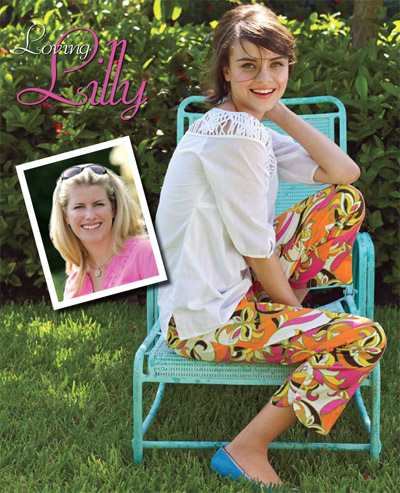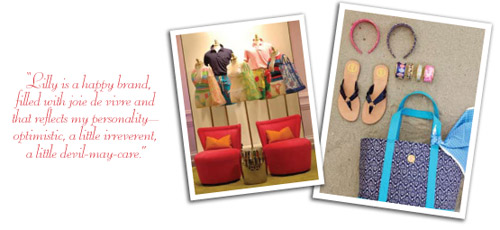
Janie Schoenborn wears Ribbet, a sunglass from the new Lilly Pulitzer Eyewear collection available from Kenmark Group.
If liking all things pink and green is a job requirement, then Jane Schoenborn (she is known as Janie) is a perfect match for Lilly Pulitzer. Schoenborn, who joined the Lilly Pulitzer company in 2006 as design director for print and pattern, brand presentation and accessories and footwear—“all the fun parts of the jobs,” she says—started her love affair with the brand at a very young age. “I come from a family of Lilly lovers,” she notes. “I grew up wearing Lilly. I have a photo of me as a child in a Lilly jellybean print swimsuit and at 35 I am still wearing Lilly. My grandmother wore Lilly wrap skirts on a regular basis. My two little girls wear Lilly. And, of course, my favorite color has always been pink, pink, pink.”
Now celebrating its 50th anniversary, the Lilly Pulitzer brand started in 1958 with a juice stand in Palm Beach. Lilly, a young New York socialite who had settled in Palm Beach with her husband, Peter Pulitzer, owner of several Florida citrus groves, needed a project so she began selling her husband’s produce from the back of a station wagon, quickly expanding to her own tiny juice stand. To conceal juice stains on her clothes, Lilly created a line of colorful dresses in vivid oranges, yellows, greens and pinks. Her customers liked her juice, but loved her dresses, which she starting hanging in the stand and selling for $22.50 a piece. The business was cemented when in 1962, a former schoolmate, First Lady Jackie Kennedy, wore a classic Lilly shift when featured in Life Magazine. The dress became a fashion sensation, growing into a lifestyle brand that has dressed three generations of women.
The brand, which sells in 75 signature stores, 21 company-owned retail locations and major department stores, now encompasses apparel for women, children and men, accessories (shoes, handbags, jewelry, belts, gifts), a complete home collection and four licenses—stationery (including party goods and office accessories), sleepwear, fragrances and eyewear. Under a licensing agreement with the Louisville, Ky.-based Kenmark Group, Lilly Pulitzer eyewear and sunwear for women and ophthalmic frames for girls/teens launched in Fall 2008.
In 1993, Lilly Pulitzer sold the brand to two Philadelphia businessmen, James Bradbeer, Jr., and Scott Beaumont, who relaunched it, moving the headquarters to King of Prussia, Pa. To reenergize and expand the brand, the two men turned to Janie Schoenborn, founder of the New York-based Buzz by Jane Fox, a preppy-inspired handbag-turned-accessories company with distribution in major department stores and boutiques nationwide.

Schoenborn, who was raised in Georgia, not only grew up loving Lilly, she also grew up knowing she wanted to work in the fashion business. After studying art history at Rollins College in Winter Park, Fla., she worked for more than 10 years in the fashion and beauty industries, including stints at Adrienne Vittadini, Calvin Klein and Barneys New York. When she began noticing the limited availability of interesting accessories, she decided to start her own business. “I carried an L.L.Bean bag [at that point Lilly Pulitzer did not have handbags in its product mix], but I wanted it in bright colors like orange that weren’t available,” she explains “Because I’m such a fan of the Lilly brand, I made bags to go with my wardrobe,” Schoenborn notes. These bags were picked up by Lilly Pulitzer for its stores. So when the two men approached her to develop Lilly Pulitzer brand accessories—although she had no plans to leave her company and move from New York—she did just that. “It’s the best decision I ever made. Working at Lilly Pulitzer is really my dream job,” she says. “Lilly is a happy brand, filled with joie de vivre and that reflects my personality—optimistic, a little irreverent, a little devil-may-care.”
The job is not without challenges, though. “Our biggest challenge is to take something familiar and make it look new, while still maintaining the Lilly look,” Schoenborn emphasizes. “We add just enough newness, whether by tweaking a fabric or combining a new style with a classic print.” For example, Schoenborn brought in handbags that invoke both past and present with Lillyisms—“every party starts by the piano and ends up in the pool”—stitched in the pockets. One bag, clear plastic with rope handles and a vibrantly colored flower print, has grommets on the bottom that can be dipped into the pool.
“We get a lot of positive feedback from our customers, whom we call ‘Lilly Lovers,’” Schoenborn explains. “They are very devoted. But if we get a product wrong, we also hear about it immediately,” she notes. “Lilly Lovers expect the brand to move forward, taking its inspiration from vintage Lilly and reappearing as modern and fresh, but always with the Lilly heritage. The colors have to be bright, clean and clear or they are rejected.”
Another challenge Schoenborn finds is dealing with seasonal needs. At one point a retailer told Pulitzer she had to make fall clothes. She replied, “It’s always summer somewhere.”
The new design team handles the seasonal issue with bright pink cable-knit sweaters and animal print boots lined in pink.
The important thing to focus on when working with accessories, Schoenborn says, is quality. “Our accessories take their direction from the clothing line. The dresses are incredibly well made with close attention to detail. We bring this dressmaker quality to all the products in the brand.”
She explains that working with other accessories helped enormously in designing the new eyewear line. “We incorporate hardware from the handbags into the frames. Seashell and coral buttons from the sweaters are translated into our jewelry collection and then cast even smaller for the eyewear.”
Eyewear was a logical extension for the brand, Schoenborn notes. “Sunglasses are a natural for us because we are associated with a resort-oriented, summery lifestyle. Optical, of course, is a logical extension of that.”
Eyewear was also obvious for Schoenborn because she wears glasses. “I always wanted hot pink glasses with gold accents. Colorful eyewear is a way to add a little zip, a little color into life,” she says. “One thing we are not going to do is boring eyewear,” she emphasizes. “Our eyewear is going to reinforce the Lilly philosophy—slightly irreverent and fun. We want to infuse the Lilly spirit into our frames and sunglasses. Happy colors for happy people.”
Schoenborn feels the optical market is open to color. Consumers are driving that interest, she says. “And if retailers love color, they will be able to sell it. One thing that gave color a push in eyewear is reading glasses,” she notes. “It’s possible to be a little crazier with readers and have fun with color.”
Eyewear is a great accessory, Schoenborn continues. “It speaks volumes about the wearer’s personality. And it’s no longer about having only one pair.”
To recharge and get inspiration, Schoenborn and her team visit Lilly Pulitzer who continues to serve as a consultant in her home in Palm Beach. “We send her boards of what we are planning. She is very willing to give us her feed back,” Schoenborn notes.
Pulitzer’s house is filled with kitschy objects—a giant fish-shaped soup tureen, a Statue of Liberty in her backyard. Any of these items can inspire a pattern. Schoenborn also stays inspired by working in her print room at the King of Prussia headquarters, filled with thousands of vintage Lilly dresses and print swatches. Each print has Lilly’s signature hidden somewhere.
Schoenborn also travels a lot. “It’s especially interesting to go to resorts and see the end result of our designs on our customers,” Schoenborn says. “It’s crazy to think we can change people’s lives, make them happier with these clothes, but we really do.”
And if she weren’t working at Lilly Pulitzer, Schoenborn would love to teach kindergarten, in a country like India. “That country is so energetic and full of color.” But for now she will focus on her “dream job” at Lilly Pulitzer.











